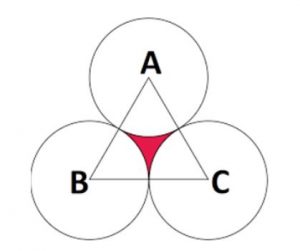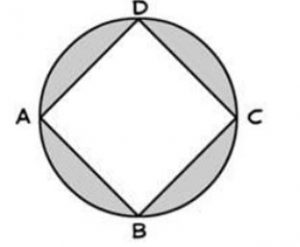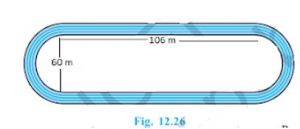Areas of Combinations of Plane Figures:
As we know how to calculate the area of different shapes, so we can find the area of the figures which are made with the combination of different figures.
Example : Find the area of the colored part if the given triangle is equilateral and its area is 17320.5 cm2 . Three circles are made by taking the vertex of the triangles as the centre of the circle and the radius of the circle is the half of the length of the side of the triangle. (π = 3.14 and √3 = 1.73205)
Solution: Given ABC is an equilateral triangle, so ∠A, ∠B, ∠C = 60°
Hence the three sectors are equal, of angle 60°.
Required ,To find the area of the shaded region.
Area of shaded region =Area of ∆ABC – Area of 3 sectors
Area of ∆ ABC = 17320.5 cm2
√3/4 × (side)2=17320.5
(side)2= (17320.5 ×4)/(1.73205 )=4 × 104
Side = 200 cm
As the radius of the circle is half of the length of the triangle, so
Radius = 100 cm
Area of Sector = θ/(360°) × π r2
= (60°)/(360°) × π (100)2
= 1/6 × 3.14 × (100)2= 15700/3 cm2
Area of 3 Sectors = 3 × 15700/3 cm2
Area of shaded region = Area of ∆ ABC – Area of 3 sectors
= 1620.5 cm2
Example : Find the area of the shaded part, if the side of the square is 8 cm and the 44 cm.
Solution: Required region = Area of circle – Area of square
= π r2 – (side)2
Circumference of circle = 2πr = 44
2 × 22/7 ×r=44
r=44 × 7/22 ×1/2=7
Radius of the circle = 7 cm
Area of circle = πr2
22/7 ×7×7 = 154 cm2
Area of square = (side)2= (8)2 = 64 cm2
Area of shaded region = Area of circle – Area of square
= 154 cm2 − 64 cm2
= 90 cm2
Exercise 12.3
Find the area of the shaded region in Fig. 12.19, if PQ = 24 cm, PR = 7 cm and O is the centre of the circle.
Solution: Here, P is in the semi-circle and so,
P = 90°
So, it can be concluded that QR is hypotenuse of the circle and is equal to the diameter of the circle.
∴ QR = D
Using Pythagorean theorem,
QR2 = PR2 + PQ2
Or, QR2 = 72 + 242
QR= 25 cm = Diameter
Hence, the radius of the circle = 25/2 cm
Now, the area of the semicircle = (π R2) )/2
= (22/7) × ( 25/2) × (25/2)/2 cm2
= 13750/56 cm2 = 245.54 cm2
Also, area of the ΔPQR = 1/(2 )× PR × PQ
= (1/2) × 7 × 24 cm2
= 84 cm2
Hence, the area of the shaded region = 245.54 cm2 −84 cm2
= 161.54 cm2
2. Find the area of the shaded region in Fig. 12.20, if radii of the two concentric circles with centre O are 7 cm and 14 cm respectively and AOC = 40°.

Solution: Angle made by sector = 40°
Radius the inner circle = r = 7 cm, and
Radius of the outer circle = R = 14 cm
We know, area of the sector = θ/(360°) × π r2
So, Area of OAC =(40°)/(360°) × π r2 cm2
= 68.44 cm2
Area of the sector OBD = (40°)/(360°) × π r2 cm2
= (1/9) × ( 22/7) × 72 = 17.11 cm2
Now, area of the shaded region ABDC = Area of OAC – Area of the OBD
= 68.44 cm2 – 17.11 cm2 = 51.33 cm2
2. Find the area of the shaded region in Fig. 12.21, if ABCD is a square of side 14 cm and APD and BPC are semicircles.
Solution: Side of the square ABCD (as given) = 14 cm
So, Area of ABCD = a2
= 14×14 cm2 = 196 cm2
We know that the side of the square = diameter of the circle = 14 cm
So, side of the square = diameter of the semicircle = 14 cm
∴ Radius of the semicircle = 7 cm
Now, area of the semicircle = (πr2)/2
= ( 22/7 × 7 × 7)/2 cm2 =
= 77 cm2
∴ Area of two semicircles = 2 × 77 cm2 = 154 cm2
Hence, area of the shaded region = Area of the Square – Area of two semicircles
= 196 cm2 −154 cm2 = 42 cm2
3.Find the area of the shaded region in Fig. 12.22, where a circular arc of radius 6 cm has been drawn with vertex O of an equilateral triangle OAB of side 12 cm as centre.
Solution: It is given that OAB is an equilateral triangle having each angle as 60°
Area of the sector is common in both.
Radius of the circle = 6 cm.
Side of the triangle = 12 cm.
Area of the equilateral triangle = (√3/4) (OA)2 = (√3/40 × 122) = 36 √3 cm2
Area of the circle = πR^2 = (22/7) × 62= 792/7 cm2
Area of the sector making angle 60° = ((60°)/(360°)) × πr2 cm2
= (1/6) × ( 22/7) × 62 cm2 = 132/7 cm2
Area of the shaded region = Area of the equilateral triangle + Area of the circle − Area of the sector
= 36√3 cm2 + 792/7 cm2 −132/7 cm2
= (36√(3 ) + 660/7) cm2
4. From each corner of a square of side 4 cm a quadrant of a circle of radius 1 cm is cut and also a circle of diameter 2 cm is cut as shown in Fig. 12.23. Find the area of the remaining portion of the square.
Solution: Side of the square = 4 cm
Radius of the circle = 1 cm
Four quadrant of a circle are cut from corner and one circle of radius are cut from middle.
Area of square = (side)2 = (4)2= 16 cm2
Area of the quadrant = ((π R2)/4) cm2 = (22/7) × (1)2)/4 = 11/14 cm2
∴ Total area of the 4 quadrants = 4 × (11/14) cm2 = 22/7 cm2
Area of the circle = π R2 cm2 = (22/7)× (1)2 = 22/7 cm2
Area of the shaded region = Area of square – (Area of the 4 quadrants + Area of the circle)
= 16 cm2 −(22/7) cm2+ (22/7) cm2
= 68/7 cm2
5. In a circular table cover of radius 32 cm, a design is formed leaving an equilateral triangle ABC in the middle as shown in Fig. 12.24. Find the area of the design.
Solution: Radius of the circle = 32 cm
Draw a median AD of the triangle passing through the centre of the circle.
⇒ BD = AB/2
Since, AD is the median of the triangle
∴ AO = Radius of the circle = ( 2/(3 )) AD
⇒ (2/(3 )) AD = 32 cm
⇒ AD = 48 cm
In Δ ADB,
By Pythagoras theorem,
AB2 = AD2 +BD2
⇒ AB2 = 482 + ( AB/2)2
⇒ AB2 = 2304+ AB2
⇒ 3/4 (AB2 ) = 2304
⇒ AB2 = 3072
⇒ AB= 32 √3cm
Area of Δ ADB = √3/4 × (32√3)2 cm2 = 768√3 cm2
Area of circle = π R^2 = ( 22/(7 ) ) × 32 × 32 = 22528/(7 ) cm2
Area of the design = Area of circle – Area of Δ ADB
= ( 22528/(7 ) – 768 √3) cm2
7. In Fig. 12.25, ABCD is a square of side 14 cm. With centres A, B, C and D, four circles are drawn such that each circle touch externally two of the remaining three circles. Find the area of the shaded region.
Solution: Side of square = 14 cm
Four quadrants are included in the four sides of the square.
∴ Radius of the circles = 14/2 cm = 7 cm
Area of the square ABCD = 142= 196 cm2
Area of the quadrant = (π R2)/4 cm2 = (22/(7 ) ×72 cm2
= 77/(2 ) cm2
Total area of the quadrant = 4 × 77/(2 ) cm2= 154 cm2
Area of the shaded region = Area of the square ABCD – Area of the quadrant
= 196 cm2 – 154 cm2 = 42 cm2
8. Fig. 12.26 depicts a racing track whose left and right ends are semicircular.
The distance between the two inner parallel line segments is 60 m and they are each 106 m long. If the track is 10 m wide, find:
(i) the distance around the track along its inner edge
(ii) the area of the track.
Solution: Width of the track = 10 m
Distance between two parallel lines = 60 m
Length of parallel tracks = 106 m
DE = CF = 60 m
Radius of inner semicircle, r = OD = O’C
= 60/2 m = 30 m
Radius of outer semicircle, R = OA = O’B
= 30+10 m = 40 m
Also, AB = CD = EF = GH = 106 m
Distance around the track along its inner edge = CD + EF+ 2 × (Circumference of inner semicircle)
= 106 + 106 + (2×πr) m = 212 + (2 ×22/7× 30) m
= 212 +1320/7 m = 2804/7 m
Area of the track = Area of ABCD + Area EFGH + 2 × (area of outer semicircle) – 2 × (area of inner semicircle)
= (AB × CD)+ (EF ×GH)+ 2 × ( (π r2)/2 ) – 2 × ((π R2)/2) m2
= (106 ×10) + (106 ×10) + 2 × π/2 (r2 – R2) m2
= 2120 + 22/7 × 70 × 10 m2
= 4320 m2
9. In Fig. 12.27, AB and CD are two diameters of a circle (with centre O) perpendicular to each other and OD is the diameter of the smaller circle. If OA = 7 cm, find the area of the shaded region.
Solution: : Radius of larger circle, R = 7 cm
Radius of smaller circle, r = 7/2 cm
Height of ΔBCA = OC = 7 cm
Base of ΔBCA = AB = 14 cm
Area of ΔBCA = 1/2 × AB × OC = (1/2) ×7×14 = 49 cm2
Area of larger circle = πR^2 = (22/7) × 72 = 154 cm2
Area of larger semicircle = 154/2 cm2 = 77 cm2
Area of smaller circle = π r2 = (22/7) × ( 7/2) × ( 7/2) = 77/2 cm2
Area of the shaded region = Area of larger circle – Area of triangle – Area of larger semicircle + Area of smaller circle
Area of the shaded region = (154 – 49 – 77 + 77/2) cm2
= 133/2 cm2 = 66.5 cm2
10. The area of an equilateral triangle ABC is 17320.5 cm2. With each vertex of the triangle as centre, a circle is drawn with radius equal to half the length of the side of the triangle (see Fig. 12.28). Find the area of the shaded region. (Use π = 3.14 and √3 = 1.73205)
Solution: ABC is an equilateral triangle.
∴ ∠ A = ∠ B = ∠ C = 60°
There are three sectors each making 60°.
Area of ΔABC = 17320.5 cm2
⇒ √3/4×(side)2 = 17320.5
⇒ (side)2 =17320.5 × 4/1.73205
⇒ (side)2= 4×104
⇒ side = 200 cm
Radius of the circles =200/2 cm = 100 cm
Area of the sector = ( (60°)/(360°) ) × π r2 cm2
= 1/6 × 3.14 ×(100)2 cm2
15700/3 cm2
Area of 3 sectors = 3 ×(15700 )/3 = 15700 cm2
Thus, area of the shaded region = Area of equilateral triangle ABC – Area of 3 sectors
= 17320.5 −15700 cm2 = 1620.5 cm2
11. On a square handkerchief, nine circular designs each of radius 7 cm are made (see Fig. 12.29). Find the area of the remaining portion of the handkerchief.
Solution: : Number of circular designs = 9
Radius of the circular design = 7 cm
There are three circles in one side of square handkerchief.
∴ Side of the square = 3 × diameter of circle = 3 × 14 = 42 cm
Area of the square = 42 × 42 cm2 = 1764 cm2
Area of the circle = π r2= (22/7) × 7 × 7 = 154 cm2
Total area of the design = 9 × 154 = 1386 cm2
Area of the remaining portion of the handkerchief = Area of the square – Total area of the design = 1764 – 1386 = 378 cm2
12. In Fig. 12.30, OACB is a quadrant of a circle with centre O and radius 3.5 cm. If OD = 2 cm, find the area of the
(i) quadrant OACB,
(ii) shaded region.
Solution: : Radius of the quadrant = 3.5 cm = 7/(2 )cm
(i) Area of quadrant OACB = ((π R2)/(4 ) cm2
= ((22/7) × ( 7/2) × ( 7/2))/(4 ) cm2
= 77/8 cm2
(ii) Area of triangle BOD = (1/2) × (7/2) × 2 cm2
= 7/(2 ) cm2
Area of shaded region = Area of quadrant – Area of triangle BOD
= (77/8) − ( 7/(2 )) cm2 = 49/(8 ) cm2
= 6.125 cm2
13. In Fig. 12.31, a square OABC is inscribed in a quadrant OPBQ. If OA = 20 cm, find the area of the shaded region. (Use π = 3.14)
Solution: : Side of square = OA = AB = 20 cm
Radius of the quadrant = OB
OAB is right angled triangle
By Pythagoras theorem in ΔOAB,
OB2 = AB2 + OA2
⇒ OB2 = 202 + 202
⇒ OB2 = 400+ 400
⇒ (OB2) = 800
⇒ OB = 20√2 cm
Area of the quadrant = ((π R2))/(4 ) cm2 = ((3.14))/(4 ) ×20√2 cm2 = 628 cm2
Area of the square = 20 × 20 = 400 cm2
Area of the shaded region = Area of the quadrant – Area of the square
= 628 – 400 cm2= 228 cm2
14. AB and CD are respectively arcs of two concentric circles of radii 21 cm and 7 cm and centre O (see Fig. 12.32). If ∠AOB = 30°, find the area of the shaded region.
Solution: Radius of the larger circle, R = 21 cm
Radius of the smaller circle, r = 7 cm
Angle made by sectors of both concentric circles = 30°
Area of the larger sector = (30°)/(360°) × π R2 cm2
= (1/12)×( 22/7) × 212 cm2
= 231/2 cm2
Area of the smaller circle = ((30°)/(360°))× π r2 cm2
= 1/12× 22/7 × 72 cm2
= 77/6 cm2
Area of the shaded region = (231/2) – (77/6) cm2
= 616/6 cm2 = 308/3 cm2
15. In Fig. 12.33, ABC is a quadrant of a circle of radius 14 cm and a semicircle is drawn with BC as diameter. Find the area of the shaded region.
Solution: Radius of the quadrant ABC of circle = 14 cm
AB = AC = 14 cm
BC is diameter of semicircle.
ABC is right angled triangle.
By Pythagoras theorem in ΔABC,
BC2 = AB2 + AC2
⇒ BC2 = 142 + 142
⇒ BC = 14√2 cm
Radius of semicircle = 14 ( 2√2 )/2 cm = 7√2 cm
Area of Δ ABC =( ( 1 )/2) ×14×14 = 98 cm2
Area of quadrant = (1/4) × (22/7) × (14×14) = 154 cm2
Area of the semicircle = ( ( 1 )/2) × (22/7) ×7√2× 7√2 = 154 cm2
Area of the shaded region =Area of the semicircle + Area of Δ ABC – Area of quadrant
= 154 + 98 −154 = 98 cm2
16. Calculate the area of the designed region in Fig. 12.34 common between the two quadrants of circles of radius 8 cm each.

Solution:
AB = BC = CD = AD = 8 cm
Area of Δ ABC = Area of ΔADC = (1/2) × 8 × 8 = 32 cm2
Area of quadrant AECB = Area of quadrant AFCD = (1/2)× 22/7 × 82
= 352/7 cm2
Area of shaded region = (Area of quadrant AECB – Area of Δ ABC) =
(Area of quadrant AFCD – Area of Δ ADC)
= (352/7 −32) + ( 352/7 − 32) cm2
= 2 × (352/7− 32) cm2
= 256/7 cm2
















